下册-Unit3第3课时单元语法讲解
人教版初中八年级英语下册第三单元Unit3教案含教学反思

⼈教版初中⼋年级英语下册第三单元Unit3教案含教学反思Section A 单词rubbish n.垃圾;废弃物fold v.折叠;对折sweep v.(swept)扫;打扫floor n.地板mess n.杂乱;不整洁throw v.(threw)扔;掷neither adv.也不; pron.两者都不shirt n.衬衫pass v.给;递;⾛过;通过borrow v.借;借⽤lend v.(lent)借给;借出finger n.⼿指hate v.厌恶;讨厌while conj.与……同时;当……的时候;⽽;然⽽chore n.杂务;乏味⽆聊的⼯作snack n.点⼼;⼩吃;快餐短语take out the rubbish 倒垃圾all the time频繁;反复as soon as ⼀……就……句型1.Peter,could you please take out the rubbish? 彼得,你能把垃圾倒了吗?2.And she won’t be happy if she sees this mess.⽽且如果她看到这么乱,她会不⾼兴的。
3.Could I at least finish watching this show?⾄少等我看完这个节⽬可以吗?4.For one week, she did not do any housework and neither did I.在—周时间⾥,她没有做任何家务,我也没有做。
that everyone should do their part in keeping it clean and tidy.既然他们和⽗母⽣活在同⼀所房⼦⾥,他们就应该知道每个⼈都应该为保持房屋的⼲净和整洁尽⼀份⼒。
5.The earlier kids learn to be independent,the better it is for their future.孩⼦们越早学会独⽴,对他们的未来就越好。
人教八年级英语下册3. Unit 3 第三课时 课件

Quiz
完成《学练优》Unit 3 第四 课时练习。
Homework
1. List the words and expressions you’ve learnt in this section.
2. If you are going to move to a new house, write a letter to your friend to ask for help.
go to the store buy drinks and snacks do the dishes clean the living room take out the rubbish
A: Could you take out the rubbish? B: Yes, sure.
A: Could you buy drinks and snacks for the party?
学练优英语教学课件
八年级(下)
学练优八年级英语下(RJ) 教学课件
Unit 3 Could you please clean your room?
Section B (1a-1e)
Lead in
What do teenagers ask for their parents’ permission for?
have a test on Monday.
探究点一 Listening
1c Listen and check() the things in activity 1a that you hear.
1. buy some drinks and snacks 2. borrow some money 3. clean your room 4. invite my friends to a party 5. go to the store 6. use your CD player
Unit 3 第3课时 Grammar-八年级英语下册(牛津译林版)

in brackets.
I __w__a_s___ (be) in Hainan last month. Some of our classmates __h_a_s_n_’_t_b_e_e_n___ (not be) to Hainan yet.
I _h_a_v_e__li_v_e_d__ (live) in Sunshine Town since I was born. Daniel ___li_v_e_d___ (live) in Nanjing in 2007.
I
(2)
_h_a_v_e_s_e_e_n_
never
so
many
wonderful pictures before.
C
Complete their conversation with the correct forms of the words
in brackets.
be buy read return see show
I ___w_r_o_t_e___ (write) an email to my friend yesterday. Daniel _h_a_s_a_l_r_e_a_d_y_w__r_it_t_en__ (write/already) two emails.
B
Help them complete the sentences with the correct forms of the words
C
Complete their conversation with the correct forms of the words
in brackets.
Millie: (5) __D_i_d_y_o_u__l_ik_e__(you/like) it?
人教版八下英语Unit3第3课时(Grammar Focus-4c)

【巧学妙记】主语借出用lend,主语借入用borrow, 想要保存用keep。
Use the content of 4a to have dialogues with your partner. Could you please pass me the salt?
3. ①Could I borrow that book? (教材P20 4a)
②Could you lend me some money? (教材P20 4a)
borrow /ˈbɒrəʊ/ ,/ˈbɑːrəʊ/ v.借;借用 lend /lend/ v. 借给;借出
【易混辨析】 borrow与lend
【拓展】lend与borrow是短暂性动词,不能与表示一段 时间的状语连用。表示 “借用某物一段时间”时,要用 keep sth. for some time。
➢ Nick borrowed a book from the library and he lent it to me. He told me that I could keep it for a week.
3. Sentences: ①—Could you please ...? —Yes, Sure./Sorry, I can’t ... ②—Could I ...? —Yes, you can./ Sorry, you can’t.
Warming up
Free talk
You could ... at home.
Unit 3 Could you please clean your room?
Section A Grammar Focus-4c
Unit 3 第3课时 Grammar语法 反意疑问句高一英语必修一(人教版2019)
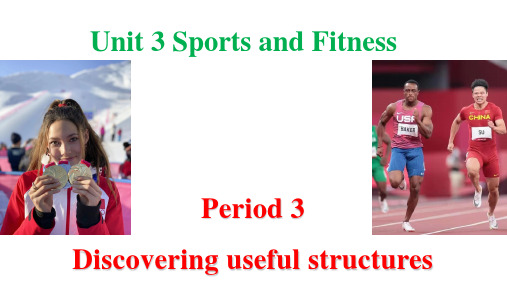
3.陈述句的主语是nobody, no one, everyone, somebody等不定代词时,反意疑问部分的主语多用 he/they。 例:Everyone knows him, don’t they/ doesn’t he? 陈述句的主语something,nothing,anything,everything 等不定代词时,反意疑问部分的主语多用it。 例:Nothing in the world is difficult, is it?
?
4. Everyone should be on time, shouldn’t they ?
5. What he said isn’t true,
is it ?
6. She dislikes sports, doesn’t she ?
7. There was a mountain, wasn’t there ?
— They don’t work hard, do they? — Yes, they do./ No, they don’t.
不,他们工作努力。/ 是的,他们工作不 努力。
2.当陈述句部分是否定结构,反意疑问句用肯定式提问时 ,回答yes或no与汉语的意思正好相反。这种回答时,yes 要翻译为“不”,no翻译为“是” 例:---Lucy didn't attend the meeting, did she? 露西没有参加会议,是吗?
Unit 3 Sports and Fitness
Period 3 Discovering useful structures
All sports for all people. —Pierre de Coubertin
初一下册三单元语法

初一下册三单元语法
初一下册第三单元的语法:
1. 一般现在时:学习一般现在时的用法,包括肯定句、否定句和疑问句的构成,以及用于表示经常性或习惯性的动作、状态或事实。
2. 人称代词和物主代词:进一步学习人称代词(如I, you, he, she, it 等)和物主代词(如my, your, his, her, its 等)的用法,包括主格和宾格形式。
3. 名词复数:学习名词复数的构成规则,例如加-s 或-es,以及一些不规则复数形式。
4. 方位介词:学习一些常用的方位介词,如in, on, under, behind, near 等,用于描述物体的位置关系。
5. 特殊疑问句:学习如何用特殊疑问词(如what, where, when, how 等)来构成特殊疑问句,并学会如何回答这些问题。
新人教版七年级下册英语 Unit 3 第3课时 教学课件

1. b bus stop
2.
a train station
3. c bus station 4. d subway station
第五页,共十四页。
新课讲解
Guessing
How does he get to work?
First, he walks to the bus stop. Then, he takes a bus to work.
A: How do you get to school?
B: Well, first, I ride my bike to the subway station. Then I take the subway.
第九页,共十四页。
新课讲解
1c Listen and check(√ ) the things that Mary wants
to know.
Mary wants to know...
___ where Bob lives. _√__ how far he lives from his grandparents’ home. _√__ how he gets to his grandparents’ home. _√__ how long it takes to get to his grandparents’ home. ___ what he thinks of the trip
第十二页,共十四页。
当堂小练
根据汉语,完成句子
1.你怎样去上学?
_H__o_w_ do you __g_e_t_t_o_s_c_h_o_o_l?
2.你住的离学校有多远?
_______do you live __________?
小学英语四年级下册Unit_3第三课时Read_and_write说课稿
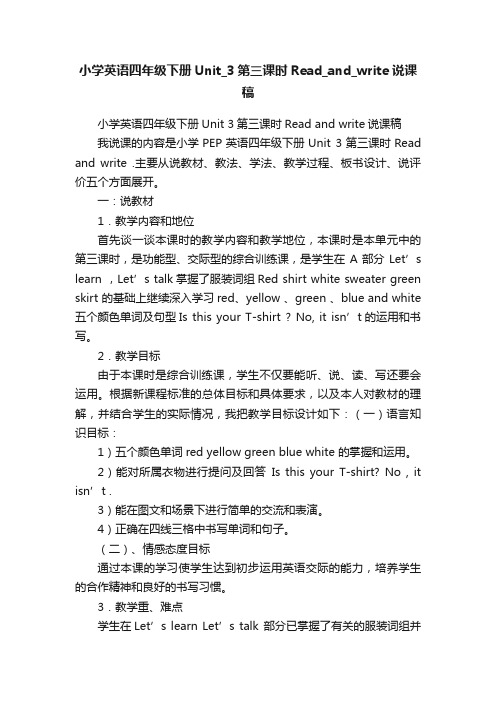
小学英语四年级下册Unit_3第三课时Read_and_write说课稿小学英语四年级下册Unit 3第三课时Read and write说课稿我说课的内容是小学PEP英语四年级下册Unit 3第三课时Read and write .主要从说教材、教法、学法、教学过程、板书设计、说评价五个方面展开。
一:说教材1.教学内容和地位首先谈一谈本课时的教学内容和教学地位,本课时是本单元中的第三课时,是功能型、交际型的综合训练课,是学生在A部分Let’s learn ,Let’s talk掌握了服装词组Red shirt white sweater green skirt 的基础上继续深入学习red、yellow 、green 、blue and white 五个颜色单词及句型Is this your T-shirt ? No, it isn’t的运用和书写。
2.教学目标由于本课时是综合训练课,学生不仅要能听、说、读、写还要会运用。
根据新课程标准的总体目标和具体要求,以及本人对教材的理解,并结合学生的实际情况,我把教学目标设计如下:(一)语言知识目标:1)五个颜色单词red yellow green blue white 的掌握和运用。
2)能对所属衣物进行提问及回答Is this your T-shirt? No , it isn’t .3)能在图文和场景下进行简单的交流和表演。
4)正确在四线三格中书写单词和句子。
(二)、情感态度目标通过本课的学习使学生达到初步运用英语交际的能力,培养学生的合作精神和良好的书写习惯。
3.教学重、难点学生在Let’s learn Let’s talk 部分已掌握了有关的服装词组并能用这些词组完成简单的句子,因此我把本课的教学重、难点设置为1)颜色单词及句型在交际中的运用2)五个单词及句子在四线三格中的正确书写。
4:教学准备教具的合理运用有助于突出重点、突破难点,使教学活动更容易操作,在这一节课中我准备了服装、奖励学生的贴画、进行书写比赛的英语书写纸、小红花、卡片等。
六年级下册英语教案-Unit3Ahealthydiet第3课时-译林版三起

教案:译林版六年级下册英语Unit 3 A healthy diet 第3课时一、教学目标1. 知识目标(1)能够听懂、会说、会读本课时出现的单词和短语:healthy, diet, doctor, food, lifestyle, junk food, nutritionist, recipe, cook, vegetable, fruit, meat, milk, egg, bread, cake,巧克力, 汉堡包, 冰淇淋, 比萨饼。
(2)能够理解并在适当的情境中运用核心句型:What doeshe/she do? He/She is a … . 以及 What does he/she do for a living? He/She is a … .(3)能够理解故事内容,并能够运用所学知识讲述一个人的职业及日常生活。
2. 能力目标(1)能够通过图片和情景,正确使用本课时的单词和句型进行交流。
(2)能够用英语简单介绍一个人的职业及日常生活。
3. 情感目标了解不同职业的特点,培养学生对劳动的尊重和热爱劳动的情感。
二、教学内容本课时主要教学内容为故事部分,通过介绍故事中的人物职业及日常生活,让学生学会运用所学知识进行交流。
三、教学重点与难点1. 重点:能够听懂、会说、会读本课时出现的单词和短语;能够理解并在适当的情境中运用核心句型。
2. 难点:单词和短语的准确运用,以及核心句型的灵活运用。
四、教具与学具准备1. 教具:多媒体课件、图片、卡片。
2. 学具:课本、练习册、单词卡片。
五、教学过程1. 导入(1)复习上一课时所学内容,引导学生回顾单词和句型。
(2)通过提问,引导学生思考本课时的学习内容。
2. 新课呈现(1)教师播放故事动画,让学生初步感知故事内容。
(2)教师引导学生跟读故事,学习本课时出现的单词和短语。
(3)教师通过图片和情景,引导学生运用核心句型进行交流。
3. 课堂练习(1)教师出示图片,引导学生用英语描述图片内容。
六年级下册英语学案-Unit3第3课时BLet'stalk|人教PEP(含答案)

六年级下册英语学案Unit3 第3课时 B Let's talk |人教PEP 教学目标:1. 知识目标:学生能够听懂、会说、会读本课时出现的单词和句型。
2. 能力目标:学生能够运用所学单词和句型进行简单的日常交流。
3. 情感目标:培养学生对英语学习的兴趣,提高他们的自信心。
教学内容:本课时主要学习第六单元第三课时的对话,内容涉及到单词"pattern", "skirt", "dress", "shirt", "blouse" 和句型 "What's this?", "It's a/an", "What's that?", "It's a/an"。
教学重点与难点:重点:单词 "pattern", "skirt", "dress", "shirt", "blouse" 和句型 "What's this?", "It's a/an", "What's that?", "It'sa/an" 的学习和应用。
难点:单词 "pattern" 的发音和词义理解。
教具与学具准备:教具:录音机、磁带、图片、卡片等。
学具:课本、练习本、铅笔、橡皮等。
教学过程:Step 1: 热身(5分钟)教师通过与学生简单的英语对话,检查学生对之前学过的内容的掌握情况,同时营造轻松的课堂氛围。
Step 2: 引入(10分钟)教师出示单词卡片,复习之前学过的单词,为新课的学习做好铺垫。
Step 3: 新课学习(15分钟)教师播放录音,让学生听懂对话内容。
人教版七年级英语下册《Unit3第三课时》学案

Unit 3 How do you get to school ? Section A (Grammar Focus-3c)第三课时语法课展示目标T eaching and learning aims学习目标:一、知识目标1. 复习Section A 所学重点内容。
2.掌握下列词汇:drive, car, live二、能力目标1.学会运用how, how long, how far引导的特殊疑问句询问出行方式、所花费的时间和两地之间的距离。
2. 一般疑问句出行方式的表达方法。
三、学习策略1. 能根据词块记忆单词。
2.在运用基础上总结它的规律。
四、情感目标了解因地域文化差别所造成的出行方式的差异。
【设计意图】目标引领,采用尽量简单的语言表述本节课的学习目标。
Teaching and Learning Steps(教学步骤):Step1. Revision1. Lead inListen to an English song How do you go to school?2. Role-play 2eAsk some pairs to role-play the conversation in 2e in front of class.【设计意图】通过复习,让同学们迅速回忆上节课的重点内容同时为本节课的学习作了铺垫。
Step2语境中感知语法(用How 询问出行方式,how long 询问花费的时间,how far询问两地之间的距离以及答语。
)1. HowGet the students to say out the transportation and different ways of transportation.Transportation(交通工具)bus plane ship train car bike/bicycle subwayon foot /walkride my bike by bike walk on footdifferent ways to schoolon the biketake the subway by subway take the bus by bus different ways to schoolin the subway on the busdifferent ways to schoolby boat take the boat take the trainby train in the boat in the train【设计意图】 通过复习为下一步的对话扫清障碍。
八年级下册人教版英语unit3知识点
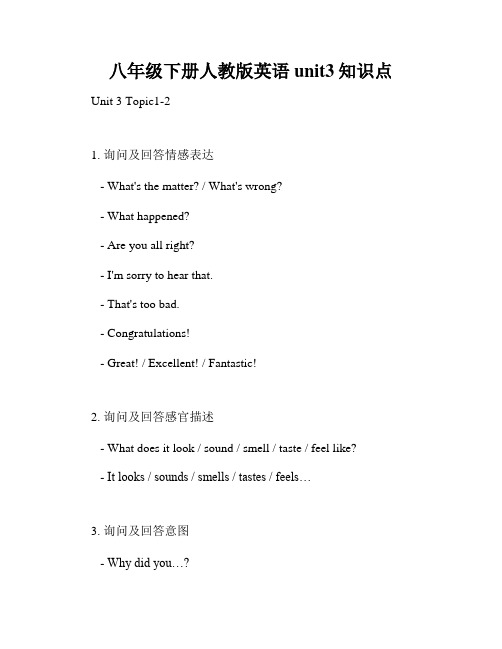
八年级下册人教版英语unit3知识点Unit 3 Topic1-21. 询问及回答情感表达- What's the matter? / What's wrong?- What happened?- Are you all right?- I'm sorry to hear that.- That's too bad.- Congratulations!- Great! / Excellent! / Fantastic!2. 询问及回答感官描述- What does it look / sound / smell / taste / feel like?- It looks / sounds / smells / tastes / feels…3. 询问及回答意图- Why did you…?- What are you going to …?- What do you intend to…?- I intend to… / I plan to…4. 问路及指路,口语表达中熟悉的方向词汇- Excuse me, could you tell me the way to…?- How can I get to…?- The nearest bus stop / subway station / bank / post office is… - It's on the left / right / opposite…Unit 3 Topic 3-41. 表达偏好及兴趣- Would you like…?- What kind of…do you like?- Do you prefer…to…?- I'm into…- I'm fond of…- I enjoy…2. 指出和辨认物品及人物(描述外貌和服装)- What does he / she look like?- He / She has…(描述头发颜色、眼睛、身材特征、穿戴等)3. 询问及描述活动安排- What are you going to do…?- What will you do…?- I'll…4. 描述天气- What's the weather like today?- It's sunny / cloudy / rainy / snowy / windy…- It's hot / warm / cool / cold…Unit 3 Topic 5-61. 表示和理解时间和星期- What time is it?- What's the date today?- What day is it today?- How many days are there in a week?- What do you usually do on weekends?2. 描述行程及活动- Tomorrow, I'm going to…(描述行程)- On Monday / Tuesday / Wednesday…, I usually… - In the morning / afternoon / evening / at night…, I…3. 询问及回答感受- How do you feel?- I feel…(描述感受)4. 描述位置- Where is the…? It's…(描述方位)以上是八年级下册人教版英语unit3的知识点总结,有效巩固这些知识点,可以让你在英语学习中更加得心应手。
人教版九年级英语Unit3第三课时Grammar精讲课件(带音频)

phrases
1.外国 2. 礼貌地寻求帮助 3.在不同的情况下 4. 例如 5.引入一个请求 6.使用恰当的语言 7.与某人交流 8.花费时间做某事 9.听起来更有/没礼貌 10.停车 11.一个地下停车场 12.去...的路
1. foreign country 2. ask for help politely 3. in different situations 4. for example/ such as 5. lead into a request 6. use the right language 7. communicate with sb. 8. spend time doing sth 9. sound more/ less polite 10. park one's car 11. an underground parking lot 12. the way to
Places 1.restroom 2.museum 3.restaurant 4.park 5.subway 6.mall .
Unit3 Could you please tell me where the restrooms are?
sound more/ less polite Excuse me, could you tell me if there's a bank in the shopping center? belongs to B. Grammar Focus Unit3 Could you please tell me
III.Let’s practice and improve.
4a Rewrite the questions to make them more polite. 1. Where can I buy some grapes or other fruit?
五年级下册英语说课稿-Unit 3 Let's make a kite 第三课时 湘少版(三起)

五年级下册英语说课稿-Unit 3 Let’s make a kite 第三课时湘少版(三起)一、教学目标1.能听懂、会说并且正确运用本课时句型:“Let’s make a kite.”2.能了解并使用本课时的生词和短语,例如 kite, paper, scissors 等。
3.能运用所学的知识、完成课堂小组活动,制作一副自己喜欢的风筝。
二、教学重难点1.教学重点:教授并强化本课时的句型,让学生们能够熟记并自如地运用它。
2.教学难点:帮助学生们正确使用英语词汇,协助他们在活动中、自由地进行英语沟通。
三、教学准备教师准备:英语课本、风筝制作的材料、比如颜料、彩笔、切割、饰物等。
学生准备:课本、笔、纸、风筝制作的材料如画纸、彩纸、剪刀、胶水等。
四、教学过程1.打招呼并引入本课“Good morning, everyone! Today, we are going to learn Unit Three: Let’s make a kite. In this lesson, we are going to learn how to make a kite and practice the senten ce ‘Let’s make a kite.’ Do you like making kites? Let’s start!”2.学习新单词与句型教师展示单词 kite,paper,scissors,然后读一遍,并让学生跟读。
学生们跟随着教师的发音,朗读并记忆单词。
接下来,教师出示一张制作风筝的简单图示,给学生以直观的感受,同时展示句型“Let’s make a kite.”,并让学生们大声跟读。
3.听力练习教师出示一张风筝的照片,并且播放一段音频资料,让学生们听录音,且尽力理解并理解录音中的主要内容。
教师播放音频两遍,让学生在听录音时,注意重点词汇。
然后,根据所听所得的信息,回答录音中相关的问题。
4.阅读练习教师让学生阅读课本,然后回答相关问题,以加深他们对风筝制作技巧、以及英文词汇的理解和掌握。
Unit 3 Weather第3课时公开课教案【英语人教三起PEP版四年级下册】

学生听音频,根据单词的读音,将单词按字母组合ar和al分为两类。
教师观察学生能否根据读音给单词正确归类。
7.Watch and repeat
学生模仿、跟读视频中的含有字母组合ar和al的单词的发音。
教师根据学生模仿发音的准确情况进行指导反馈,进行纠音。
设计意图:本阶段学习活动旨在帮助学生在对语篇进行听、唱、读、看的过程中,感悟单词中字母组合ar和al的发音规律。学生先通过听力任务整体感知语篇,然后朗读、吟唱语篇,进一步发现字母组合及其发音规律。再通过归类、跟读的活动,巩固字母组合的发音。在感知、理解语音知识的同时,也培养了学生发现、分析、总结、归纳的思维能力。
—Can I have some soup? —Yes, you can.
—What’s the weather like in New York? —It’s rainy.
—Is it cold? —No, it isn’t.
2.能够在情境中运用句型“Can I go outside now? Yes, you can. / No, you can’t.”“What’s the weather like in …? It’s …”询问他人意见、天气情况,并能回答。
2.能够读出符合ar, al发音规则的单词,并能够根据发音拼写出符合ar, al发音规则的单词。
文化意识
1.了解中国幅员辽阔,各地天气差异明显。
2.能够了解气温描述的文化差异,了解华氏温度、摄氏温度的区别。
3.了解世界主要城市的天气差异,以及谈论天气所具有的寒暄功能。
4.了解同一时间,南北半球季节不同。
3.能够在情境中运用句型“It’s … and … It’s … in …”描述气候特征和天气情况。
人教版英语七年级下册Unit3第三课时SectionA(GrammarFocus-3c)教案
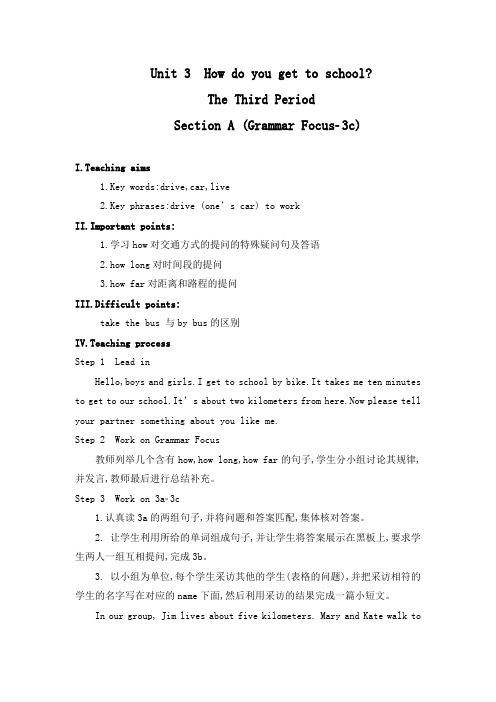
Unit 3 How do you get to school?The Third PeriodSection A (Grammar Focus3c)I.Teaching aims1.Key words:drive,car,live2.Key phrases:drive (one’s car) to workII.Important points:1.学习how对交通方式的提问的特殊疑问句及答语2.how long对时间段的提问3.how far对距离和路程的提问III.Difficult points:take the bus 与by bus的区别IV.Teaching processStep 1 Lead inHello,boys and girls.I get to school by bike.It takes me ten minutes to get to our school.It’s about two kilometers from here.Now please tell your partner something about you like me.Step 2 Work on Grammar Focus教师列举几个含有how,how long,how far的句子,学生分小组讨论其规律,并发言,教师最后进行总结补充。
Step 3 Work on 3a3c1.认真读3a的两组句子,并将问题和答案匹配,集体核对答案。
2. 让学生利用所给的单词组成句子,并让学生将答案展示在黑板上,要求学生两人一组互相提问,完成3b。
3. 以小组为单位,每个学生采访其他的学生(表格的问题),并把采访相符的学生的名字写在对应的name下面,然后利用采访的结果完成一篇小短文。
In our group, Jim lives about five kilometers. Mary and Kate walk toschool. Sally takes a bus to school. Tom goes to school by bike. Jim needs about an hour to get to school. Mary and Kate need about ten minutes to get to school.Language points1.drive的用法drive 动词,意为“开车;驾驶”。
三年级下册英语-Unit 3 第3课时 A.let's spell 教案
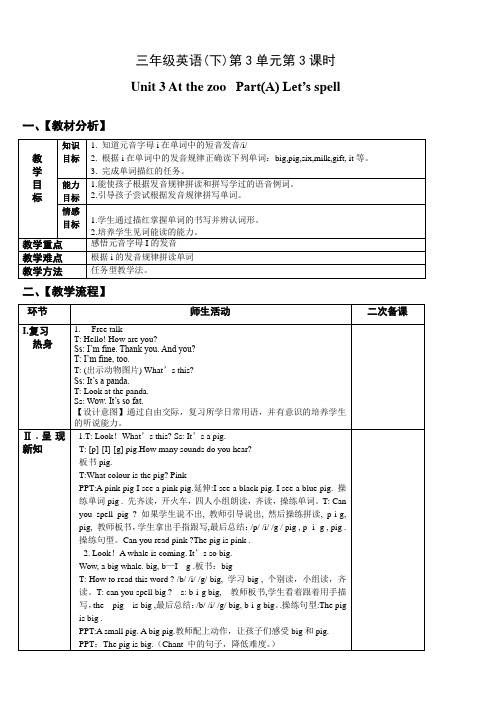
三年级英语(下)第3单元第3课时Unit 3 At the zoo Part(A) Let’s spell 一、【教材分析】二、【教学流程】T:What’s this?The elephant is big,too.3. How many pigs?Let’s count together.S: 1 , 2…..six pigs .six /s/ /i/ /ks/ six 操练单词six,. 齐读,小组读,齐读操练单词。
T: can you spell six ? 教师板书. 学生看着跟着用手描写,t six /s/ /i/ /ks/ six ,最后总结:/s/ /i/ /ks/ six ..操练句型。
4.师做喝牛奶的动作,并说:I like milk. Do you like milk? 引出milk. T: Look at the pig, what does it like? The pig likes milk .S: milk. /m/ /i/ /l/ /k / milk , 操练单词milk. 小组,齐读操练单词。
T: can you spell milk ? .教师板书. 学生看着跟着用手描写,T : m-i-l-k milk.Can you read?最后总结:/m/ /i/ /l/ /k / milk , m-i-l-k milk.操练句型。
教师呈现big, pig, six, milk四个单词的单词卡,让学生读出单词,然后让学生找找这四个单词的共同点。
(单词中都有字母i,i都发/i/音)但学生对这四个单词都发/i/音的规律不一定能说出,教师要引导并鼓励学生通过观察体验自己去发现和总结。
2. 播放课文录音,让学生进一步熟悉字母i在单词中的发音并跟着录音拼读单词。
(1)Listen and repeat.(2)Read together.(3)Read in pairsⅢ.巩固练习1.Play a game教师说一个单词,学生从字母卡中找出3个字母组成一个单词,同时叫2个学生,看谁做得快,谁就获得胜利,奖励一个笑脸。
Unit 3 第3课时 课文讲解及语法拓展-2022-2023学年六年级英语下册同步(牛津上海版)

A.have B.having
C.to have
D.had
10.May has got too much homework, so she would like to have _______
Zongzi
sweet … with beans sweet … without beans
salty … with meat salty … without meat
Me
like not like
like not like
like not like
like not like
like not like
mouse- mice
(4)不可数名词
不可数名词所表示的事物一般不能用数来计算,没有词形变化,
也不能与a,an直接连用。如果不可数名词需要计量时,用“数
词或冠词+量词+of+不可数名词”这样的结构来表示,量词可以
是单数也可以是复数,但of后的名词只能是单数。
e. g. a bottle of milk一瓶牛奶
Not like sweet … with beans salty … without meat salty … with meat salty … without meat
I like …, but I don’t like …
Name
Like
Peter salty … with meat
Joe sweet … without beans
Kitty sweet … without beans
Alice sweet … with beans
Peter likes …, but he doesn’t like … …
